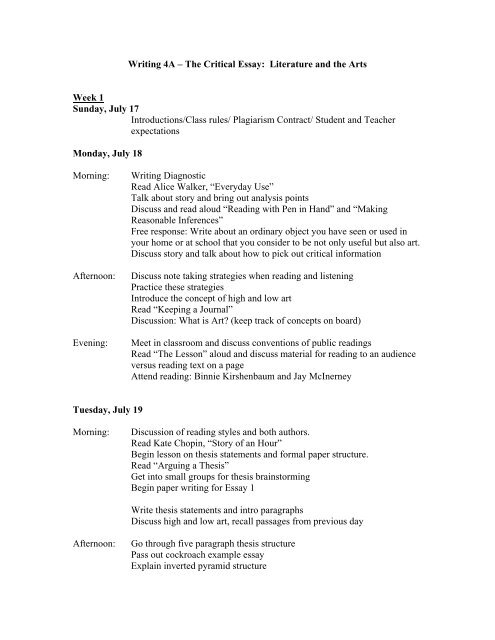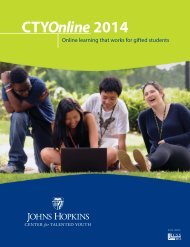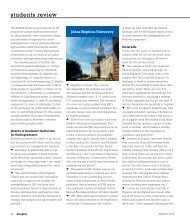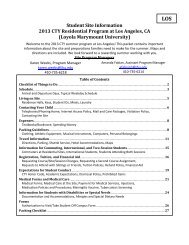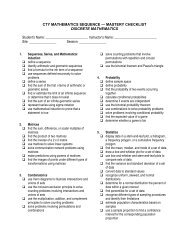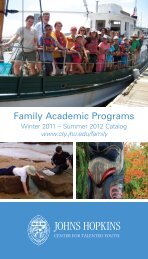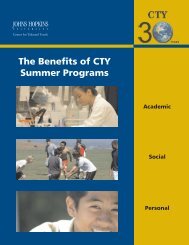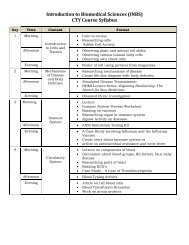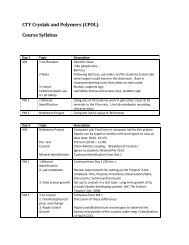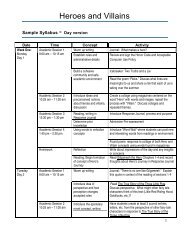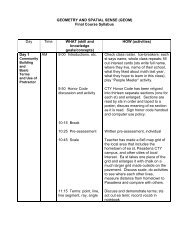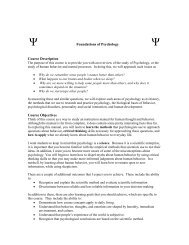Writing 4A – The Critical Essay: Literature and the Arts
Writing 4A – The Critical Essay: Literature and the Arts
Writing 4A – The Critical Essay: Literature and the Arts
You also want an ePaper? Increase the reach of your titles
YUMPU automatically turns print PDFs into web optimized ePapers that Google loves.
<strong>Writing</strong> <strong>4A</strong> – <strong>The</strong> <strong>Critical</strong> <strong>Essay</strong>: <strong>Literature</strong> <strong>and</strong> <strong>the</strong> <strong>Arts</strong><br />
Week 1<br />
Sunday, July 17<br />
Introductions/Class rules/ Plagiarism Contract/ Student <strong>and</strong> Teacher<br />
expectations<br />
Monday, July 18<br />
Morning:<br />
Afternoon:<br />
Evening:<br />
<strong>Writing</strong> Diagnostic<br />
Read Alice Walker, “Everyday Use”<br />
Talk about story <strong>and</strong> bring out analysis points<br />
Discuss <strong>and</strong> read aloud “Reading with Pen in H<strong>and</strong>” <strong>and</strong> “Making<br />
Reasonable Inferences”<br />
Free response: Write about an ordinary object you have seen or used in<br />
your home or at school that you consider to be not only useful but also art.<br />
Discuss story <strong>and</strong> talk about how to pick out critical information<br />
Discuss note taking strategies when reading <strong>and</strong> listening<br />
Practice <strong>the</strong>se strategies<br />
Introduce <strong>the</strong> concept of high <strong>and</strong> low art<br />
Read “Keeping a Journal”<br />
Discussion: What is Art? (keep track of concepts on board)<br />
Meet in classroom <strong>and</strong> discuss conventions of public readings<br />
Read “<strong>The</strong> Lesson” aloud <strong>and</strong> discuss material for reading to an audience<br />
versus reading text on a page<br />
Attend reading: Binnie Kirshenbaum <strong>and</strong> Jay McInerney<br />
Tuesday, July 19<br />
Morning:<br />
Discussion of reading styles <strong>and</strong> both authors.<br />
Read Kate Chopin, “Story of an Hour”<br />
Begin lesson on <strong>the</strong>sis statements <strong>and</strong> formal paper structure.<br />
Read “Arguing a <strong>The</strong>sis”<br />
Get into small groups for <strong>the</strong>sis brainstorming<br />
Begin paper writing for <strong>Essay</strong> 1<br />
Write <strong>the</strong>sis statements <strong>and</strong> intro paragraphs<br />
Discuss high <strong>and</strong> low art, recall passages from previous day<br />
Afternoon:<br />
Go through five paragraph <strong>the</strong>sis structure<br />
Pass out cockroach example essay<br />
Explain inverted pyramid structure
Write body paragraphs <strong>and</strong> conclusion<br />
Evening:<br />
Lab time: Revise essay drafts written that afternoon<br />
Wednesday, July 20<br />
Morning:<br />
Discuss: <strong>The</strong> difference between film <strong>and</strong> literature—how literature is<br />
adapted <strong>and</strong> concerns of audience<br />
Read “Identifying Your Audience <strong>and</strong> Purpose”<br />
Film: <strong>The</strong> Joy that Kills (film adaptation of “Story of an Hour”) (1 hr.)<br />
Afternoon:<br />
Break into small groups: Discuss main differences in film <strong>and</strong> text <strong>and</strong><br />
which is more effective for <strong>the</strong> audience <strong>and</strong> why<br />
Present group findings to class<br />
Read “Brainstorming” <strong>and</strong> “Focused Free <strong>Writing</strong>”<br />
20 minute free-write<br />
Visit Schick Gallery exhibit: “Anything but Realism”<br />
H<strong>and</strong>out on Surrealism, Dadaism, <strong>and</strong> political reactions to realism<br />
movements<br />
Evening:<br />
Lab time for 1 hour to finish typing draft for peer review<br />
Jamaica Kincaid <strong>and</strong> Henri Cole reading in Davis Auditorium<br />
Thursday, July 21<br />
Morning:<br />
Afternoon:<br />
Evening:<br />
Read h<strong>and</strong>out “What is Art?”<br />
Discuss concepts introduced in essay<br />
Discuss loose essay structure<br />
Peer review in small groups: each student does two reviews<br />
Charles Simic poem<br />
Fur<strong>the</strong>r discussion of Surrealism<br />
Examination of Salvador Dali <strong>and</strong> Rene Magritte works<br />
Discussion of surrealist ideas<br />
Pick surrealist painting to analyze for next paper<br />
Yaddo project: pick famous writers to research<br />
Lab time for conducting research on project<br />
Type final revision of essay 1 <strong>and</strong> turn in<br />
Film: Martin Scorsese’s <strong>The</strong> Age of Innocence
Friday, July 22<br />
Morning:<br />
Take students to Yaddo for garden tour <strong>and</strong> discussion of assigned<br />
personalities<br />
Onsite presentations of each personality or artist<br />
Afternoon: Assign essay 2<br />
Discuss <strong>The</strong> Age of Innocence: high art <strong>and</strong> low art<br />
Week 2<br />
Sunday, July 24<br />
Evening: Finish essay 2 <strong>and</strong> turn in; begin revision process on essay 1<br />
Monday, July 25<br />
Morning:<br />
Afternoon:<br />
Read “Reading <strong>and</strong> <strong>Writing</strong> about Visual Culture”<br />
Individual analysis of Doro<strong>the</strong>a Lange’s “Migrant Mo<strong>the</strong>r” without<br />
reading text<br />
Share ideas in class <strong>and</strong> <strong>the</strong>n read <strong>the</strong> accompanying information with<br />
short lecture on historical circumstances of Dust Bowl <strong>and</strong> Hooverville,<br />
<strong>and</strong> <strong>the</strong> Great Depression<br />
Read samples of journal entries <strong>and</strong> <strong>the</strong>n show students series of pictures<br />
<strong>and</strong> ask <strong>the</strong>m to journal for 15 minutes in class; plan to use <strong>the</strong>se journal<br />
entries to construct essay 3<br />
Read article from Smithsonian on posing photographs <strong>and</strong> au<strong>the</strong>nticity<br />
Discuss validity of constructing art versus discovering it in natural context<br />
Picasso essay, “Art <strong>and</strong> Truth”<br />
Student journal writing<br />
Assign essay 3 on art <strong>and</strong> truth<br />
Read Claude McKay, Countee Cullen, Gwendolyn Brooks, <strong>and</strong> Zora Neal<br />
Hurston<br />
Lecture on Black <strong>Arts</strong> Movement<br />
Music from Harlem Renaissance: computer lab research on aspects of<br />
Harlem Renaissance <strong>and</strong> Black <strong>Arts</strong> movement<br />
Gil Scott Heron: Black <strong>Arts</strong> music<br />
Students choose one poem to explicate <strong>and</strong> begin explication<br />
Use notes to begin <strong>the</strong>sis formulation for essay 3
Evening:<br />
Students work on finishing essay 2 <strong>and</strong> begin essay 3 draft<br />
Tuesday, July 26<br />
Morning:<br />
Historical information about Harlem Renaissance<br />
Read Langston Hughes, “Harlem” “<strong>The</strong>me for English B” “Salvation”<br />
Discuss poem explication<br />
Practice poem explication as a class<br />
Write <strong>the</strong>sis as a group for a sample essay<br />
Demonstrate quoting techniques for poetry<br />
Practice MLA paren<strong>the</strong>tical citations<br />
Students revise work done <strong>the</strong> previous night on essay 3<br />
Peer pairs for peer review<br />
Discuss art as dialogue<br />
Read Sacco <strong>and</strong> Vanzetti; review immigration in 20 th c. America<br />
Read “Not Sacco <strong>and</strong> Vanzetti”<br />
Group work discussing dialogue<br />
Switch papers from revised essay: students create a short response to <strong>the</strong>ir<br />
peers’ essays <strong>and</strong> use strategies of artistic dialogue (add to <strong>the</strong> discussion<br />
as well as tweak <strong>the</strong> ideas in <strong>the</strong> original)<br />
Afternoon:<br />
Introduce concept of literary style as barrier to acceptance as art<br />
Introduction to minimalism<br />
Read Raymond Carver, “What We Talk About When We Talk About<br />
Love”<br />
Discuss in small groups<br />
Present findings to class<br />
Read aloud Carver parody, “What We Talk About When We Talk About<br />
Donuts”<br />
Discuss strategies of parody as literary form<br />
Does parody automatically devalue <strong>the</strong> original work or heighten <strong>the</strong> value<br />
<strong>and</strong> raise it to artistic status?<br />
Evening: Revisions based on peer review for essay 3<br />
Wednesday, July 27<br />
Morning:<br />
More work on revisions from essay 3 in computer lab<br />
Introduce “surprise ending in fiction”; talk about literary or artistic value<br />
Read Shirley Jackson, “<strong>The</strong> Lottery”<br />
Stop before <strong>the</strong> end of Jackson’s story; have students write <strong>the</strong> ending on<br />
<strong>the</strong>ir own<br />
Read student endings in class
Have students read <strong>the</strong> rest of <strong>the</strong> story <strong>and</strong> compare <strong>the</strong>ir endings to <strong>the</strong><br />
author’s: Do <strong>the</strong>y feel cheated by <strong>the</strong> ending or like <strong>the</strong> twist?<br />
Afternoon:<br />
Evening:<br />
Student Reading: In progress work<br />
Turn in essay 3<br />
Assign parts <strong>and</strong> read aloud Susan Glaspell, Trifles<br />
Switch around so everyone has a part at least once<br />
Finish acting out Trifles if <strong>the</strong> class hasn’t done so<br />
Journal on how students feel about drama as art vs. poetry, painting,<br />
fiction, or sculpture<br />
Thursday, July 28<br />
Morning:<br />
Afternoon:<br />
Evening:<br />
Discuss value of art in a culture: differences in cultures for art funding<br />
Discuss societal st<strong>and</strong>ards of what qualifies as art; reiterate high <strong>and</strong> low<br />
art discussion<br />
Read article on art <strong>the</strong>ft from Smithsonian magazine<br />
Discuss valuable art students have seen or witnessed <strong>and</strong> its purpose in<br />
serving a culture<br />
Contemporary art versus classical art (dance, sculpture, painting, <strong>and</strong><br />
music); examine why people recoil from modern or contemporary art<br />
claiming that “<strong>the</strong>y could do that” so it’s not art<br />
Read X. J. Kennedy, “Nude Descending Staircase” <strong>and</strong> compare to Marcel<br />
Duchamp’s painting of <strong>the</strong> same title<br />
Read John Updike, “Before <strong>the</strong> Mirror” <strong>and</strong> compare to Picasso’s Girl<br />
Before a Mirror; discuss Cubism <strong>and</strong> stylistics<br />
Introduce found poetry <strong>and</strong> provide examples<br />
Discuss merits of found poetry; tell students to find something to bring to<br />
evening session in order to create <strong>the</strong>ir own found poems<br />
Use samples to create found poems individually; work on a group poem<br />
from found work<br />
Friday, July 29<br />
Field Trip<br />
Massachusetts MOCA (note taking or journal response at end of day)
Week 3<br />
Sunday, July 31<br />
Evening:<br />
Use notes to construct an argument about a sculpture or painting from <strong>the</strong><br />
museum. Free write in journal about <strong>the</strong> experience. Focus on one work or<br />
a group of works that are related <strong>the</strong>matically<br />
Monday, August 1<br />
Morning:<br />
Afternoon:<br />
Discuss cultural values of art: view Van Gogh’s paintings<br />
Discuss Van Gogh’s biography<br />
Have students draw or present ordinary everyday thing <strong>the</strong>y would<br />
consider an art object if <strong>the</strong>y were a practicing contemporary artist<br />
Does Van Gogh’s tragic story make his art more valuable?<br />
Discuss <strong>the</strong> value of art once an artist is dead.<br />
Show paintings of Jackson Pollack<br />
Break students into groups. Let <strong>the</strong>m draw a piece of paper with <strong>the</strong> name<br />
of an ordinary object on it. <strong>The</strong> group <strong>the</strong>n has to decide how to present<br />
<strong>the</strong> object to o<strong>the</strong>rs to make it artistic as if it were entered in a show or<br />
writing contest.<br />
Class presentations of each group<br />
Evening:<br />
Students are asked to write down an object noun<br />
Each student draws a piece of paper <strong>and</strong> <strong>the</strong>n has to write a perspective<br />
piece from <strong>the</strong> perspective of that object<br />
Read David Sedaris excerpt from Me Talk Pretty One Day about<br />
performance art<br />
Tuesday, August 2<br />
Morning:<br />
Discuss if <strong>the</strong> advent of multiple artists make something less valuable or<br />
artistic<br />
Do exercise of poetry writing: Exquisite Corpse<br />
Play telephone game to demonstrate how story telling can change <strong>and</strong> be<br />
refined; have each person add <strong>the</strong>ir own twist to <strong>the</strong> story so that it gets<br />
tweaked<br />
Afternoon: Pick topics for essay 4<br />
Work on formulating <strong>the</strong>sis <strong>and</strong> body paragraphs<br />
Write first drafts<br />
Peer review<br />
Evening:<br />
Revise essay 4 based on peer review
Wednesday, August 3<br />
Morning: Continue revising essay 4<br />
Read Ernest Hemingway, “Cat in <strong>the</strong> Rain”<br />
List comparisons on board between Hemingway’s style <strong>and</strong> Raymond<br />
Carver’s style<br />
Afternoon: Turn in essay 4<br />
Read F. Scott Fitzgerald, “Babylon Revisted”<br />
Compare Fitzgerald to Hemingway<br />
Trick <strong>the</strong> Teacher writing exercise using a style reviewed in class<br />
Evening:<br />
Film: Richard Brooks’ <strong>The</strong> Last Time I Saw Paris<br />
Thursday, August 4<br />
Morning:<br />
Commercial success as artist<br />
Review Hemingway <strong>and</strong> Fitzgerald: plots of stories about artists’<br />
success<br />
Finding meaning in success<br />
Read “What is Art?” from Short Takes<br />
Afternoon:<br />
Evening:<br />
Journal about if concept of art has changed, how etc.?<br />
Share <strong>the</strong>se ideas in class.<br />
Turn in final journal projects<br />
Review time for anything left undone or not finished<br />
Friday, August 5<br />
Morning:<br />
Afternoon:<br />
Student reading<br />
Convocation Ceremony<br />
Meet with Parents


